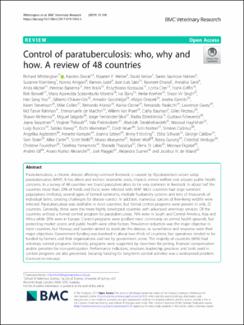Control of paratuberculosis: who, why and how. A review of 48 countries

View/
Date
2019-12-01Author
Whittington, Richard
Donat, Karsten
Weber, Maarten F
Kelton, David
Saxmose Nielsen, Søren
Eisenberg, Suzanne
Arrigoni, Norma
Juste, Ramon
Sáez, Jose Luis
Dhand, Navneet
Santi, Annalisa
Michel, Anita
Barkema, Herman
Kralik, Petr
Kostoulas, Polychronis
Citer, Lorna
Griffin, Frank
Barwell, Rob
Scatamburlo Moreira, Maria Aparecida
Slana, Iva
Koehler, Heike
Vir Singh, Shoor
Sang Yoo, Han
Chávez-Gris, Gilberto
Goodridge, Amador
Ocepek, Matjaz
Garrido, Joseba
Stevenson, Karen
Collins, Mike
Alonso, Bernardo
Cirone, Karina
Paolicchi, Fernando
Gavey, Lawrence
Tanvir Rahman, Md
De Marchin, Emmanuelle
Van Praet, Willem
Bauman, Cathy
Fecteau, Gilles
McKenna, Shawn
Salgado, Miguel
Fernández-Silva, Jorge
Dziedzinska, Radka
Echeverría, Gustavo
Seppänen, Jaana
Thibault, Virginie
Fridriksdottir, Vala
Derakhshandeh, Abdolah
Haghkhah, Masoud
Ruocco, Luigi
Kawaji, Satoko
Momotani, Eiichi
Heuer, Cord
Norton, Solis
Cadmus, Simeon
Agdestein, Angelika
Kampen, Annette
Szteyn, Joanna
Frössling, Jenny
Schwan, Ebba
Caldow, George
Strain, Sam
Carter, Mike
Wells, Scott
Munyeme, Musso
Wolf, Robert
Gurung, Ratna
Verdugo, Cristobal
Fourichon, Christine
Yamamoto, Takehisa
Thapaliya, Sharada
Di Labio, Elena
Ekgatat, Monaya
Gil, Andres
Nuñez Alesandre, Alvaro
Piaggio, José
Suanes, Alejandra
De Waard, Jacobus H
Metadata
Show full item recordAbstract
Paratuberculosis, a chronic disease affecting ruminant livestock, is caused by Mycobacterium avium subsp. paratuberculosis (MAP). It has direct and indirect economic costs, impacts animal welfare and arouses public health concerns. In a survey of 48 countries we found paratuberculosis to be very common in livestock. In about half the countries more than 20% of herds and flocks were infected with MAP. Most countries had large ruminant populations (millions), several types of farmed ruminants, multiple husbandry systems and tens of thousands of individual farms, creating challenges for disease control. In addition, numerous species of free-living wildlife were infected. Paratuberculosis was notifiable in most countries, but formal control programs were present in only 22 countries. Generally, these were the more highly developed countries with advanced veterinary services. Of the countries without a formal control program for paratuberculosis, 76% were in South and Central America, Asia and Africa while 20% were in Europe. Control programs were justified most commonly on animal health grounds, but protecting market access and public health were other factors. Prevalence reduction was the major objective in most countries, but Norway and Sweden aimed to eradicate the disease, so surveillance and response were their major objectives. Government funding was involved in about two thirds of countries, but operations tended to be funded by farmers and their organizations and not by government alone. The majority of countries (60%) had voluntary control programs. Generally, programs were supported by incentives for joining, financial compensation and/or penalties for non-participation. Performance indicators, structure, leadership, practices and tools used in control programs are also presented. Securing funding for long-term control activities was a widespread problem.
